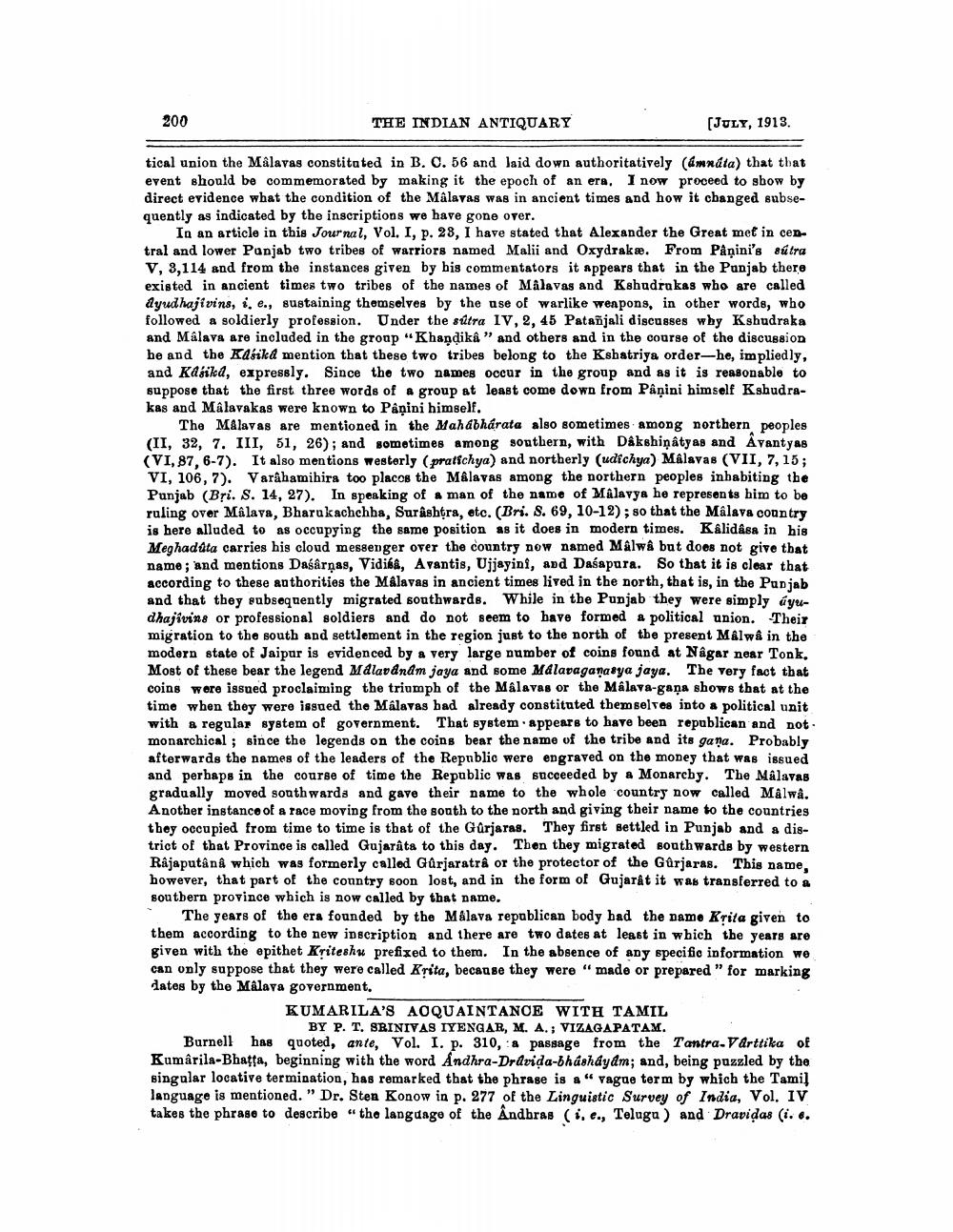________________
200
THE INDIAN ANTIQUARY
(JULY, 1913
tical union the Mâlavas constitated in B. C. 56 and laid down authoritatively (annáta) that that event should be commemorated by making it the epoch of an era. I now proceed to show by direct evidence what the condition of the Malayas was in ancient times and how it changed subsequently as indicated by the inscriptions we have gone over.
In an article in this Journal, Vol. I, p. 28, I have stated that Alexander the Great met in central and lower Panjab two tribes of warriors named Malii and Oxydrakæ. From Påņini's sútra V, 3,114 and from the instances given by bis commentators it appears that in the Punjab there existed in ancient times two tribes of the names of Málavas and Kshudrokas who are called ayudhajivins, i.e., sustaining themselves by the use of warlike wenpons, in other words, who followed a soldierly profession. Under the sutra IV, 2, 45 Patañjali discusses why Kshudraka and Malava are included in the group "Khandika” and others and in the course of the discussion he and the Kasik& mention that these two tribes belong to the Kshatriya order-he, impliedly, and Kasikd, expressly. Since the two names occur in the group and as it is reasonable to suppose that the first three words of a group at least come down from Pâņini himself Kshudrakas and Mälavakas were known to Pâņini himself,
The Malavas are mentioned in the Mahabharata also sometimes among northern peoples (II, 32, 7. III, 51, 26); and sometimes among southern, with Dakshiņâty as and Avantyas (VI, 87, 6-7). It also mentions westerly (pratichya) and northerly (udfchya) MÁlavas (VII, 7,15; VI, 106, 7). Varahamibira too places the Malayas among the northern peoples inbabiting the Punjab (Bţi. S. 14, 27). In speaking of a man of the name of Malayya he represents him to be ruling over Mâlava, Bharukachchha, Surashtra, etc. (Bri. S. 69, 10-12); so that the Mâlava country is here alluded to as occupying the same position as it does in modern times. Kalidasa in his Meghadata carries his cloud messenger over the country now named Malwâ but does not give that name; and mentions Daśårņas, Vidika, Avantis, Ujjayini, and Dasapura. So that it is clear that according to these authorities the MÁlavas in ancient times lived in the north, that is, in the Punjab and that they subsequently migrated southwards. While in the Punjab they were simply áyudhajiving or professional soldiers and do not seem to bave formed a political union. Their migration to the south and settlement in the region just to the north of the present Mâlwê in the modern state of Jaipur is evidenced by a very large number of coins found at Nagar near Tonk, Most of these bear the legend Malavdnám jaya and some Malavaganasya jaya. The very fact that coins were issued proclaiming the triumph of the Malavas or the Mâlava-gana shows that at the time when they were issued the Malavas bad already constituted themselves into a political unit with a regular system of government. That system appears to have been republican and not monarchical; since the legends on the coins bear the name of the tribe and its gaña. Probably afterwards the names of the leaders of the Republic were engraved on the money that was issued and perhaps in the course of time the Republic was succeeded by a Monarcby. The Mâlavas gradually moved southwards and gave their name to the whole country now called Mâlwa. Another instance of a race moving from the south to the north and giving their name to the countries they occupied from time to time is that of the Gurjaras. They first settled in Punjab and a district of that Province is called Gujarâta to this day. Then they migrated southwards by western Rajaputânâ which was formerly called Gûrjaratrâ or the protector of the Gurjaras. This name, however, that part of the country soon lost, and in the form of Gujarat it was transferred to a southern province which is now called by that name.
The years of the era founded by the Malava republican body had the namo Krita given to them according to the new inscription and there are two dates at least in which the years are given with the epithet Kriteshu prefixed to them. In the absence of any specific information we can only suppose that they were called Krita, because they were "made or prepared " for marking dates by the MÁlava government.
KUMARILA'S ACQUAINTANCE WITH TAMIL
BY P. T. SRINIVAS IYENGAR, M. A.; VIZAGAPATAM. Burnell has quoted, ante, Vol. I. p. 310, & passage from the Tantra-Varttika of Kumârila-Bhatta, beginning with the word Andhra-Dravida-bhashayam; and, being puzzled by the singular locative termination, has remarked that the phrase is a " vague term by which the Tamil language is mentioned." Dr. Sten Konow in p. 277 of the Linguistic Survey of India, Vol. IV takes the phrase to describe “the language of the Andbras (i, e., Telugu ) and Dravidas (i. 6.




